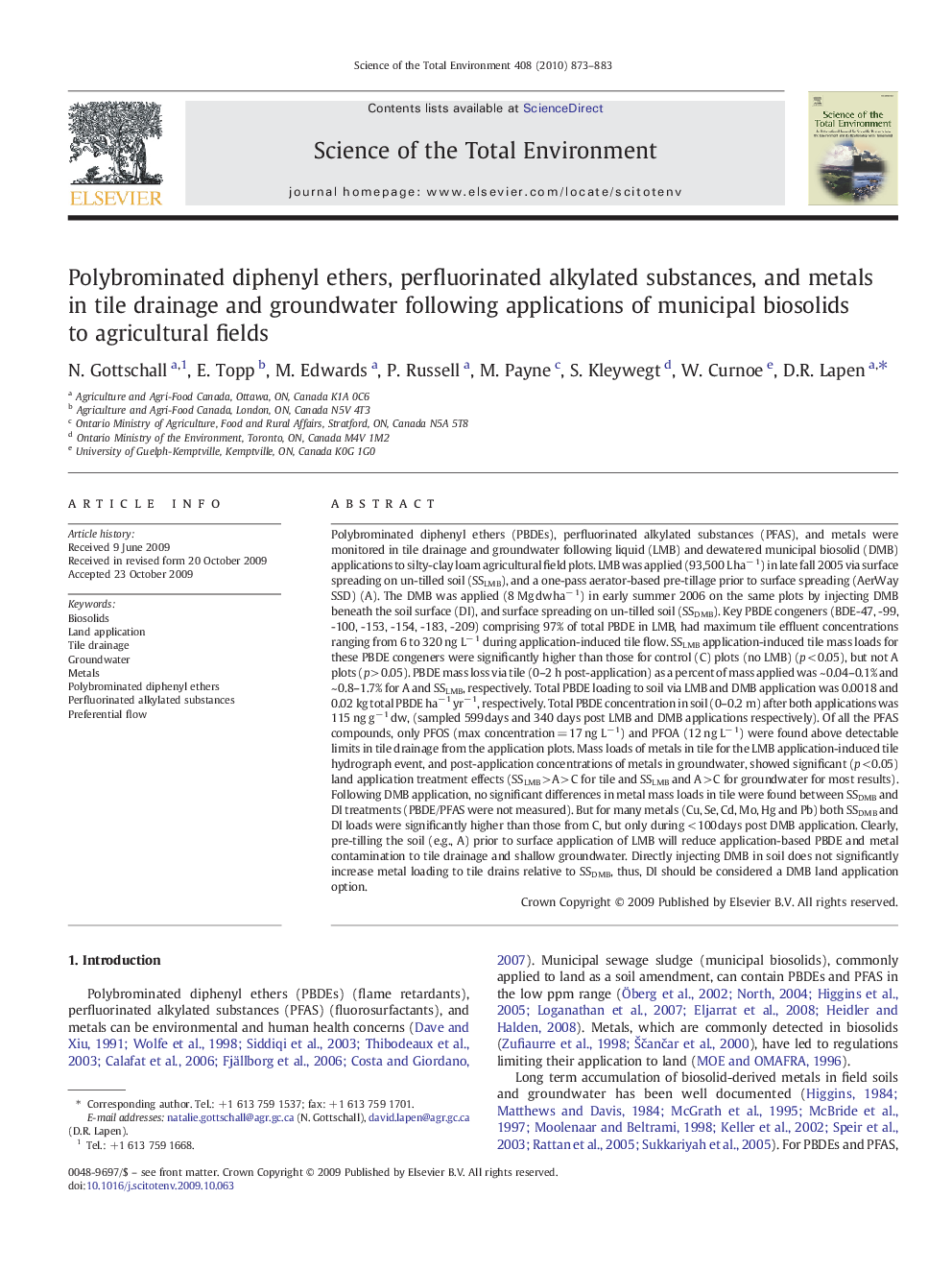| کد مقاله | کد نشریه | سال انتشار | مقاله انگلیسی | نسخه تمام متن |
|---|---|---|---|---|
| 4430801 | 1619882 | 2010 | 11 صفحه PDF | دانلود رایگان |

Polybrominated diphenyl ethers (PBDEs), perfluorinated alkylated substances (PFAS), and metals were monitored in tile drainage and groundwater following liquid (LMB) and dewatered municipal biosolid (DMB) applications to silty-clay loam agricultural field plots. LMB was applied (93,500 L ha− 1) in late fall 2005 via surface spreading on un-tilled soil (SSLMB), and a one-pass aerator-based pre-tillage prior to surface spreading (AerWay SSD) (A). The DMB was applied (8 Mg dw ha− 1) in early summer 2006 on the same plots by injecting DMB beneath the soil surface (DI), and surface spreading on un-tilled soil (SSDMB). Key PBDE congeners (BDE-47, -99, -100, -153, -154, -183, -209) comprising 97% of total PBDE in LMB, had maximum tile effluent concentrations ranging from 6 to 320 ng L− 1 during application-induced tile flow. SSLMB application-induced tile mass loads for these PBDE congeners were significantly higher than those for control (C) plots (no LMB) (p < 0.05), but not A plots (p > 0.05). PBDE mass loss via tile (0–2 h post-application) as a percent of mass applied was ~ 0.04–0.1% and ~ 0.8–1.7% for A and SSLMB, respectively. Total PBDE loading to soil via LMB and DMB application was 0.0018 and 0.02 kg total PBDE ha− 1 yr− 1, respectively. Total PBDE concentration in soil (0–0.2 m) after both applications was 115 ng g− 1 dw, (sampled 599 days and 340 days post LMB and DMB applications respectively). Of all the PFAS compounds, only PFOS (max concentration = 17 ng L− 1) and PFOA (12 ng L− 1) were found above detectable limits in tile drainage from the application plots. Mass loads of metals in tile for the LMB application-induced tile hydrograph event, and post-application concentrations of metals in groundwater, showed significant (p < 0.05) land application treatment effects (SSLMB > A > C for tile and SSLMB and A > C for groundwater for most results). Following DMB application, no significant differences in metal mass loads in tile were found between SSDMB and DI treatments (PBDE/PFAS were not measured). But for many metals (Cu, Se, Cd, Mo, Hg and Pb) both SSDMB and DI loads were significantly higher than those from C, but only during < 100 days post DMB application. Clearly, pre-tilling the soil (e.g., A) prior to surface application of LMB will reduce application-based PBDE and metal contamination to tile drainage and shallow groundwater. Directly injecting DMB in soil does not significantly increase metal loading to tile drains relative to SSDMB, thus, DI should be considered a DMB land application option.
Journal: Science of The Total Environment - Volume 408, Issue 4, 15 January 2010, Pages 873–883